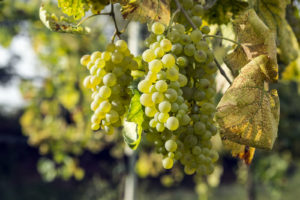
Vineyards in Campania
When the days are warm to hot, and the sunsets linger longer, nothing refreshes like Campania’s (Italy) quartet of ancient white grapes: Coda di Volpe, Falanghina, Fiano, and Greco.
These lovely white varieties are found in wines produced throughout the region, sometimes in white blends and frequently as single varieties. All four of these varietals have their own personality and flavor profiles that cannot be accurately described by comparing them to better-known international varieties. While they are all more akin to Sauvignon Blanc than Chardonnay, to say that any of them are reminiscent of Sauvignon Blanc would be a great inaccuracy.
One thing that Coda di Volpe, Falanghina, Fiano, and Greco do have in common is an ancient history. Most were enjoyed during the time of the Roman Empire, and all were very close to extinction by the 1970s when they were saved by a handful of adventurous and conserving winemakers like Mastroberardino.
Coda di Volpe (98% found in Campania) name translates to tail of the fox due to the shape of the grape bunches. Coda di Volpe is often used in the region’s white blend, frequently paired with the other three white varieties featured in this story. Coda di Volpe has recently become more popular as a single-varietal wine — this is a good thing.
Coda di Volpe has a very distinctive flavor profile, offering notes of quince, green apple, and pear with bright, citrus-like acidity and a pronounced salinity, especially in its youth. With a little bit of bottle age, it can show flavors of dried fruits, tropical fruit, honey, and, at times, a faint smokiness.
This variety grows throughout the region of Campania, adapting well to various soils and sun exposures. The grape’s skins are quite thick and rich in polyphenols that sometimes translate to a deeper golden color. As long as Coda di Volpe is not left to hang on the vine too long, over-ripening and losing its trademark acidity, it provides wines of great character and hedonistic charm.

Falanghina Grapes
Falanghina (91% found in Campania), along with Aglianico (the region’s most important red variety), is believed to be Campania’s oldest varietal.
It is believed by many that Falanghina was the base grape used in the ancient wine Falernum (a wine mentioned frequently in ancient Roman literature). There are several varietals that make this claim, and as of now, it’s impossible to know, but in my view, Falanghina makes a compelling case.
The name is believed to have derived from the Latin falangae (phalanx in English), as the common vine support poles resembled a typical Roman legion’s formation. Beyond its namesake, Falanghina was a favorite of Roman soldiers who were known to take vine cuttings with them, planting them in other regions and, at times, other countries. Who knows how many Falanghina vines, now called something else, have survived. Not surprisingly, there are many different variants of Falanghina in Campania, and much work has been done to identify the best variants for local cultivation. (Falanghina Beneventana and Falanghina Flegrea are the leading variants of Falanghina.)
Today, a good number of Falanghina wines are sold in the USA. Falanghina is the key component in several appellations throughout Campania, with Falanghina del Sannio DOC being perhaps the most significant in export markets.
Falanghina offers unique flavors and aromas of wildflowers, citrus (redolent of lemon), peach, blanched almonds, and honey with fresh mineral notes as well. It’s typically not an age-worthy wine, best being consumed two to four years from its vintage.
Fiano (65% Campania, 16% Sicilia, and 15% Puglia) is truly one of Italy’s great white wine grapes. The grape seems to hail from Lapio, a small ancient town in the province of Avellino. The best examples of Fiano can be found in the wines of the Fiano di Avellino DOCG appellation. These wines must be a minimum of 85% Fiano, and sometimes there are small portions of Coda di Volpe and Greco in the blend.
Fiano, too, was nearly extinct in the 1970s, but it has made a miraculous comeback.
Fiano, especially in Fiano di Avellino, creates beautiful and delicious wines with flavors and aromas of pear, green melon, orange peel, hazelnut, and a faint to pronounced pinecone accent. Serve it chilled but not too cold, as the aromas tend to bloom in the glass as it warms a bit. Fiano is typically drunk young, but the best examples can age for a decade in the cellar.

Lovely Greco di Tufo
Greco (61% Campania with Calabria being the next significant region) is a great and versatile grape grown in the south of Italy. Despite its name, this varietal is not related to any known varietals from Greece.
Greco’s greatest expression can be found in the wines of Greco di Tufo DOCG. Greco expresses its deep and somewhat wild flavors here in the rich volcanic soils. These wines are both generously acidic while being oily and rich on the palate, with a bit of tannin on the finish. Greco di Tufo exhibits flavors and aromas of wildflowers, stone fruits (both dried and fresh), pear, green apple, earth, nuts, and honey. Greco di Tufo will almost always benefit from a few years of bottle age and is a great choice to serve with grilled fish.
We encourage you to seek out this great quartet of wines from Campania. Start an Italian flavor exploration in your own home that may inspire you to fly to the source someday soon.
